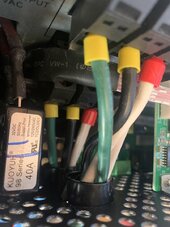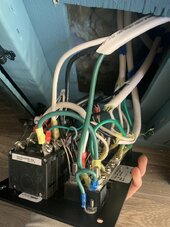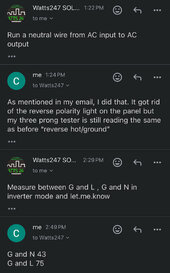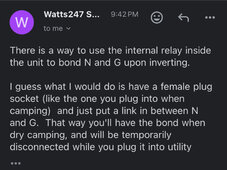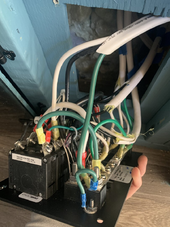If these units work as perfectly as you claim then why are there literally dozens of threads and YouTube videos about how to deal with the problem I laid out? Is my breaker panel OCD compliant? No. But it is perfectly safe and I have consulted with Paneltronics and can confirm it is wired properly. Additionally, if the problem was at the panel then it would show up regardless of whether using shore or inverter power as its all the same wiring at that pint in the circuit.
Did you do as I instructed? It has to be determined if N-G is bonded in the inverter under inverter power and there is only one way to find out. You have to test with all wires disconnected on AC input and output. The older versions bonded N-G dynamically under inverter power but later models may have had internal changes that are not documented. You can't go by what some clown on the web tells you, you have to test it yourself. You are looking for the easy answer without performing actual testing.
If the inverter bonds N-G under inverter power and you add another N-G bond by jumpering or a bonding plug, objectionable current will flow on G, thus you will get what you describe as you have a parallel path on G. While Ian does have some good points, he also has some practices I'd call questionable and can lead to inverter damage, failure to clear a ground fault and even severe shock to yourself.
As you did not give the model of the Paneltronics panel,
we all get to guess on what you have. The more information provided certainly helps others know what exactly you have. I had to do some more digging to find what appears to be your AC panel. The correct diagram is this one.
https://www.paneltronics.com/docs/wiring/2305.pdf?v=20240219042206 Looking at that diagram, there is a N-G bond on that panel at the top where G attaches to the panel. The terminal below it is N. There is a jumper between N and G and this is why you are seeing your problem. No, this is not wired correctly. The bond between N and G at that point needs to be removed. You have a parallel path and I'm quite certain when you
actually test the inverter as I described in
this post, you will find that indeed this inverter is bonding N-G under inverter power.
You can thank me later, I'm just some guy on the internet that owns one of these units and how it operates but don't know squat according to your response.



